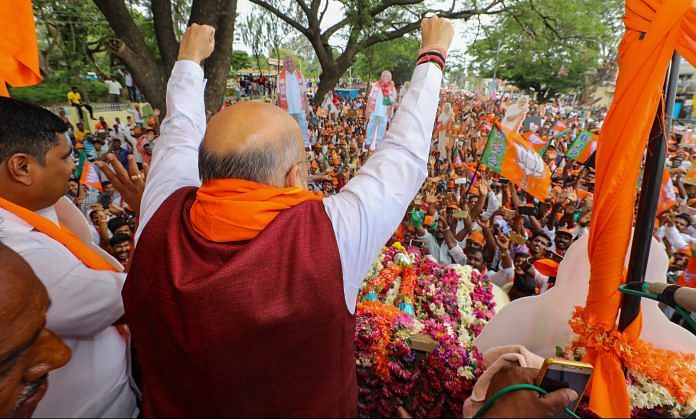Asserting sub-nationalism gave Karnataka politics an identity issue that distracted from Hindutva identity issues.
Brand Modi, the promise of vikas, a dose of nationalism, and Hindutva polarisation are the elements of a standard anti-incumbency campaign by the BJP. The party has tried all of these in Karnataka, but it is clear that Hindutva doesn’t have the same resonance here as it did in Gujarat or Uttar Pradesh.
That is not for want of trying. The BJP has tried Hindutva polarisation not just in the communally-sensitive coastal region, but across the state. Be it Tipu Sultan or Pakistan, the standard, expected tropes have been used.
The main reason for the failure of Hindutva polarisation in this Karnataka election is the pre-emptive measures taken by chief minister Siddaramaiah.
One was the assertion of Kannada identity against Hindi and North India. Siddaramaiah introduced a polarisation other than Hindu-Muslim polarisation. People were given the Karnataka flag controversy to debate. A new flag was designed and adopted by the state government, waiting for approval from the Centre. Hindi signboards were removed.
This strategy was similar to the ‘Bihari versus Bahari’ strategy adopted by Nitish Kumar in Bihar elections in 2015. Asserting sub-nationalism gave Karnataka politics an identity issue that distracted from Hindutva identity issues. It put the BJP in a dilemma, as the party asserts Indian nationalism along with Hindutva.
Second, chief minister Siddaramaiah’s AHINDA caste strategy to create a political coalition of minorities, Dalits and OBCs makes sure that caste overrides Hindutva. In Karnataka, lower OBCs are largely with the Congress — as opposed to states like Gujarat or Uttar Pradesh, where lower OBCs have become a BJP vote-bank. In Karnataka, the BJP is very much an upper caste party, with Lingayats as its core vote base. First used in 2013, the AHINDA strategy, with which Siddaramaiah and Congress are almost openly excluding the upper castes, is somewhat similar to the backward-forward polarisation Nitish Kumar and Lalu Yadav engineered in Bihar in 2015. Caste polarisation, therefore, overrides Hindutva polarisation.
As if that was not enough, Siddaramaiah went one step forward to make the BJP anxious about its own core vote-base. His move to ask the Centre to give religious minority status to the Lingayat community, many say, is unlikely to bring much electoral gain to the Congress. The move has caused much confusion. Perhaps that was the point. The Lingayat move was meant more to make the BJP anxious about its own vote bank, and distract it away from doing Hindutva polarisation. As the political discourse became all about Lingayats, it reduced the BJP’s ability to talk about those fearful Muslims.
Fourth, Siddaramaiah has taken a heavy-handed approach in preventing Hindutva polarisation. Last September, the BJP planned a ‘Mangalore Chalo’ bike rally of party workers from across the state. It was to be led by firebrand Hindutva leaders of the party. The Siddaramaiah government did not go on the backfoot, and promptly issued prohibitory orders, detaining at least 800 BJP workers, including senior leaders such as former deputy CM R. Ashok, and party MPs Shobha Karandlaje and Pratap Simha.
Fifth, it is only in three of the state’s 30 districts that Hindutva politics has taken deep roots. These three districts, with 19 assembly seats, form the coastal Karnataka region. The districts of Dakshin Kannada, Udupi and Uttara Kannada have seen Kerala-like internecine political violence. The BJP has made exaggerated claims of 23 BJP workers having been killed by extremist Muslim groups. One of them was even found alive.
Given Hindutva polarisation, the BJP should be sweeping at least this region, but is unlikely to do so. One reason is that Hindutva footsoldiers here include the OBC community of Billavas (toddy tappers), who feel the BJP hasn’t given them enough tickets this time. The Billava rebellion includes a Facebook page that calls for Billavas to cast NOTA on the voting machines.
There has also been a counter-consolidation of Muslims and Christians along with backward castes in favour of the Congress. While the BJP will still not do badly here, the fact that it is projected to not sweep even the Hindutva bastion shows how Hindutva has failed in this Karnataka election.
The BJP’s rhetoric over Tipu Sultan doesn’t convince its own supporters because its chief ministerial candidate, B.S. Yeddyurappa, has flip-flopped on Tipu Sultan. That tells you how poorly the Hindutva plank has played out for the BJP in Karnataka.







Saw the results Mr sickular libtard termite?
No one talks about Muslim Polarization done by Secular parties?
Do not expect from Paid Journalist who sold their soul.